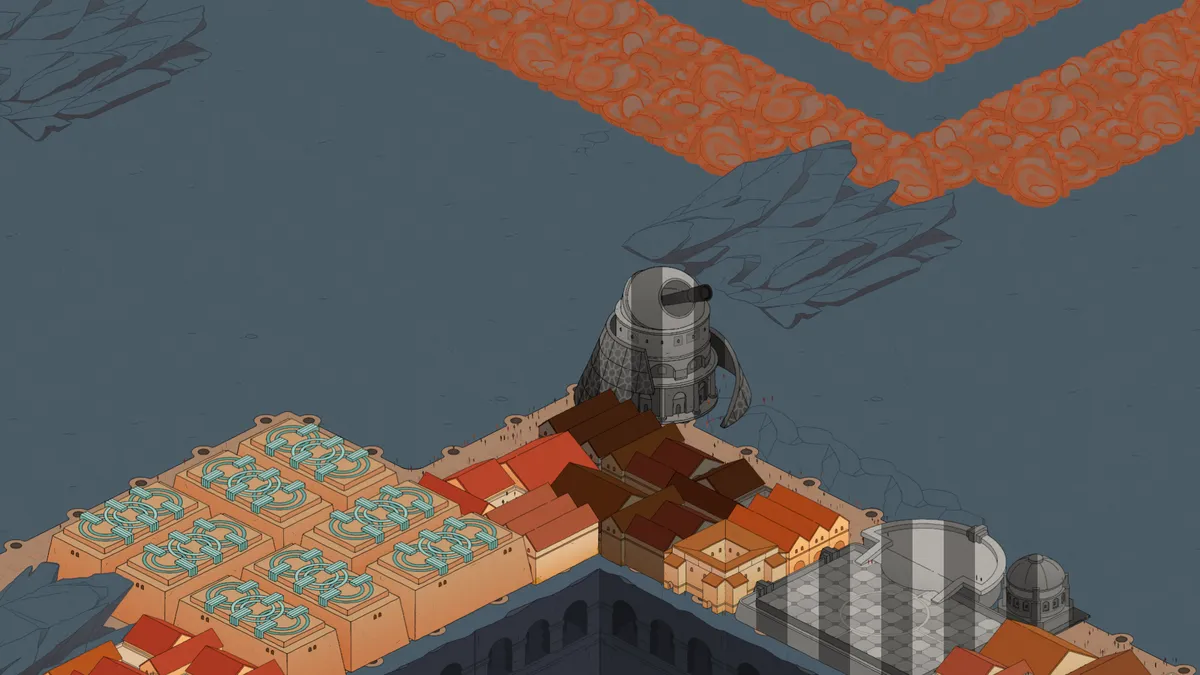Population and People
Amberspire Design Diary #7
See the other design diaries, wishlist the game, or subscribe to our newsletter. As the early design was formulated into a prototype, I wanted to address a couple of loose ends in the broad conception of a city builder: labor and population. These are important elements I wanted to represent but not be too complex in themselves, and build on my thoughts on cellular automata.
I've been playing and thinking about city builders for a long time, and along the way I realized I wanted to do my own spin on houses and population. This was partly born out of thinking about cellular automata, but also realizing that typically in city builders I am not engaged by placing houses or residential districts. Unless I am giving myself a very specific external motivation for doing so (a visual appeal or extra challenge) I'll just do the bare minimum the game requires and nothing more. In a sense, I'd like the population to be either something I think about a lot less or a lot more.
Population
City builders use population as a kind of overall set of buckets for the systems the game is modeling: happiness, wealth, education etc, of which Amberspire does not have any. One reason for this is that the focus of the game is broader, the city in Amberspire can grow to be a massive metropolis, the interactions with the world around it are more political in nature, so we didn't want the design to be so complex as to track individual people. Another is that typically these systems heavy city builders are built on the assumptions of the 20th century, and typically in industrialized areas. Even with a displaced time period or location, I feel like the assumptions are still present. Which, in itself is neither here nor there, but I want Amberspire to feel like a science fantasy city builder, beyond just unusual names and architecture.
Given other production constraints, I did not have the capability to design and implement the ideas I had for how a city several millennia in our future might operate – though those ideas are present in the writing and art.
All that to say, I wanted the representation of labor, population, and people in Amberspire to be relatively simple, out of the player's control, and reinforce the science fantasy theme.

Labor
Initially I was very confounded with how to represent labor in Amberspire. A typical city builder will track workers or some kind of value within a building, and modulate the building's output based on skill or morale or whatever else the game is concerned with. Since the focus of Amberspire is not that fine-grained, and building output is already variable with dice, how to should the game represent labor?
Some ideas that didn't go anywhere, to start things off: dice themselves could change, with faces becoming blank or have some penalty modifier if rolled. Or when the resource is used in another building, its effectiveness is modified somehow.
These probably could have worked, but didn't feel right and clashed with other plans I had. I didn't want the dice themselves to be overloaded with complexity or be so variable that the player couldn't guarantee what the die would be – before it's even rolled! This kind of 'double uncertainty' can very quickly go awry.
Another promising idea: houses were buildings that rolled a ‘labor’ die, and to construct buildings you’d need to supply labor resources from house die. This somewhat works, but not at the range of scales I wanted to operate with. For a huge space fantasy metropolis, a building could be the neighborhood market or an entire spaceport. If a few ‘labor’ resources can build a market, then dozens would build a spaceport. Rolling dozens of dice was out of the question, a firm constraint for the game.

Simple and Out of Control Houses
My solution is to both of these issues is first to remove the house building from the player’s toolkit altogether. As a player you will never just ‘build houses’. Residents, as houses, grow in the city as a function of you operating other buildings or various other events. Residents also don’t roll dice at all. When you construct a building, it must be able to reach a certain number of residents within a range of that building. While that building is under construction, those residents are reserved and unable to be used for constructing another building.
Removing house building removes a key interaction for the player (which is the part I typically find unengaging) but adds a distinct texture to the game. Like cellular automata, residents grow semi-randomly, sometimes filling in gaps and sometimes creating unusual shapes. Buildings you construct as a player will affect an appeal value for spaces in the world, so the player does have some general direction, but not totally.
The unusual shapes created by the residents will force you to build in odd and unconventional ways, working how you can with the residents. My goal here is to feel like the city has truly interesting districts and neighborhoods, arising both out of whim and chance and your desires as a player.
The restriction for constructing a building addresses both the representation of labor and nice limitation on player construction together. It’s also an idea that is easily and immediately communicated to the player: you have strong but clear limitations about where buildings can go, and how many you can place. Buildings can also vary a lot in their needs, the aforementioned market only reserving a few adjacent houses while a spaceport requires dozens over a huge area of land.
The population and neighborhoods will take on a life of their own exactly because the player didn’t place them, but watched them grow out of the city. My hope is that cities will have truly unique and unexpected designs because of this feature, and I’m very excited for it.